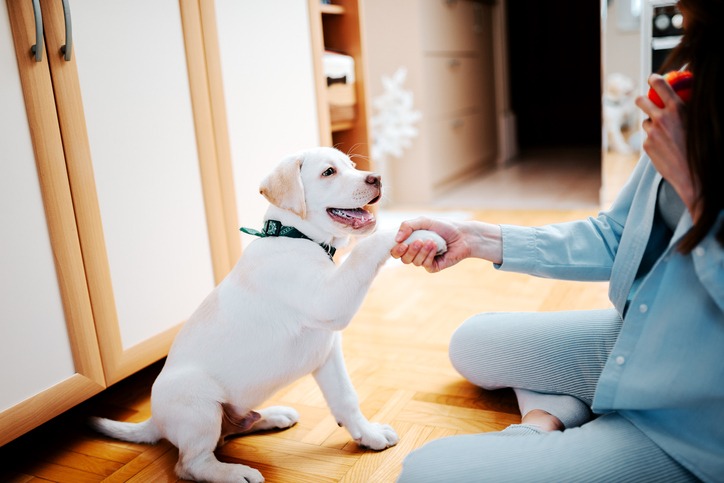How Soon Should You Start Training With Your New Pup?
When Can You Start Training Your Puppy?
Puppies are always learning, from the time they’re very little. They learn from their moms, from their environment, from socializing with people and animals, and through direct training. While specific training, like the training given in service dog training programs, may need to wait until the pup is an adolescent, basic puppy training should begin as early as possible. When you begin training on the day you bring your puppy home, you are creating a solid foundation for your pup to become a confident adult dog. To learn more about how to train a puppy, read on.

What to Consider While Training Your New Pup:
- Puppies have a primary social development window that closes around 16 weeks of age. Before this window closes, they need exposure to people, animals, objects, and environments that you will need them to be comfortable with in the long term. Make these interactions safe and fun, so that your puppy comes away from them feeling happy.
- New puppies, as well as many newly adopted dogs, have no knowledge of our domestic human world and the strange expectations that go along with it. They don’t know what they can chew, where they can potty, and where they are allowed to explore. It is our job to teach them what’s expected of them, not just by telling them no, but also by telling them what they can do. Rather than constantly telling your dog no, catch the pup doing the right thing, and give praise and rewards for that behavior. Positive reinforcement can work wonders in dog training.
- Training shouldn’t be traumatic for your puppy. Whether you are training a puppy or an adult dog, the training should never be painful or scary. If it is, the dog may develop unwanted behaviors, like fear or aggression. Dogs that behave badly often do not understand what’s expected or don’t yet have the impulse control to live up to expectations. Be patient with your puppy, teaching the correct behavior repeatedly, until your dog understands.
- Your dog’s adolescence can reflect early learning. Adolescent dogs can be difficult to manage. They’re not those cute little puppies anymore, but can be impulsive, bad at listening, and annoying. That is why it is so important to train your puppy in the first several months of life, rather than waiting until he or she is six to eight months old to start training. A puppy who has been trained early will be easier to handle in adolescence because those impulse control skills will carry through as the puppy grows.
Tips for Training Your Puppy:
- Use Positive Reinforcement. Positive reinforcement is the only acceptable and scientifically backed method of training, whether you’re asking how to house-train a puppy, how to get a dog to walk on a leash, or how to stop unwanted behaviors. With positive reinforcement, you give a reward to encourage wanted behavior, without punishing for unwanted behaviors. Using punishments and harsh corrections, correcting devices like shock, prong, or choke collars, or dominance-based handling techniques can be counterproductive, causing long-term consequences that result in a fearful, anxious older dog. It may take some trial and error to find out which rewards work best for your particular puppy. Some might be excited by a piece of kibble, while others might need something like a training treat, and still others won’t be motivated by food at all. If you have a non-food motivated puppy, try to find a toy that the pup can enjoy after doing a good job. Puppies also respond to praise, petting, and showing excitement.
- Keep Training Sessions Brief. Puppies, like little children, have short attention spans. Try to keep your training sessions for basic cues to about five minutes apiece, for a total of 15 minutes per day. End your session on a positive note, and your pup will be excited for the next one.
- Be Consistent When Training Your Puppy. Whether you’re working on leash training a puppy, puppy potty training, or learning simple commands, consistency is perhaps the most important element of training. Use the same word and/or the same hand signal every time you are working with your puppy on a basic cue like sit, stay, or come. Reinforce desired behaviors even if it’s inconvenient. If your puppy needs to go out and you’re busy, stop what you are doing, take the puppy outside, and offer rewards for a successful potty break.
- Practice in Different Environments. It’s one thing to have a well-behaved pup at home, but it’s important not to have a loose cannon when you leave the house. Giving a cue or command at the beach or a park is very different than giving it at home, so it’s worthwhile to practice your puppy’s training where interesting new sights and smells will be distracting. You want your puppy to grow into a dog who is confident regardless of the situation. One caveat: Do not take your puppy into areas with a lot of other dogs until the puppy vaccinations are complete.
- Have Patience. Puppies, like little children, are always growing and learning. You can expect them to make mistakes or not understand what you are asking of them. Try not to be frustrated if your puppy is not progressing as quickly as you expected, but just keep things consistent and establish a routine that will help your puppy feel secure and ready to learn.
Puppy Training Timeline:
We’ve said you should start training early, but when should you start with different types of training? Here, we offer a helpful timeline to give you a general idea of when to try training for new things.
- At 7 to 8 weeks old, puppies can learn the basics. You can begin teaching cues like “sit” by saying the word once, using a treat to get the puppy into a sitting position, then giving the treat and praising for a “good sit.” Puppies this age should definitely be handled because you want your puppy accustomed to being touched. Rub the ears and paws while giving rewards, and you’ll make vet visits easier. You can also begin leash training inside your house, beginning by putting on the collar or harness for short amounts of time, slowly increasing the duration, and always rewarding with treats. Once the pup is used to it, start walking around on a leash indoors, without distractions. Once all the vaccinations are complete, move the leash training outside.
- 8 to 10 weeks old is the perfect age to start crate training. You want your pup to see the crate as a safe, calm place, never a place of punishment. Start crate training by putting the puppy in the crate for ten-minute intervals of calm. Give rewards for going into the crate, or feed the puppies in the crate to create a positive association with being in there.
- 10 to 12-week-old puppies need to learn not to bite. Puppies explore the world by putting things in their mouths, but around this age, they become a bit too mouthy. It is very important to teach them not to bite people, so if your puppy bites your hands or ankles, redirect to a more appropriate biting object, like a toy.
- At 12 to 16 weeks of age, be very consistent with potty training. Take the puppy out first thing in the morning, after meals, and after playtime and naps. Puppies this age should begin to have enough bladder control to learn how to wait to go out. Make sure to give rewards for going potty outside.
- 6 months old is the most difficult age for training. Puppies at this age are entering the aforementioned adolescent stage, and they are poor listeners with low impulse control. That is why it is so important to begin their training in the much younger stages when they are more malleable and eager to please. During adolescence, however, you will want to keep up the training to solidify and strengthen all the skills you’ve been working on since they were little. It is important to take them out to distracting places like dog parks, to reinforce the skills you have been teaching and help build their dependability in public.
Why Choose K-9 University for Dog Training and Boarding?
When you need someone to help you train or care for your dog, trust the dedicated staff at K-9 University. We are happy to help with obedience training that will teach your dog to listen to you and help the two of you build a strong relationship. Whether you need boarding, grooming, doggy daycare, or dog training programs, we offer individualized attention and professional pet services honed from time-proven practices. We’ve served families in North Texas for over 30 years, and our highly trained, knowledgeable staff is available at our two convenient locations in Garland and Plano to provide training and pet care solutions to meet your needs. Call for more information or contact us through our website.
